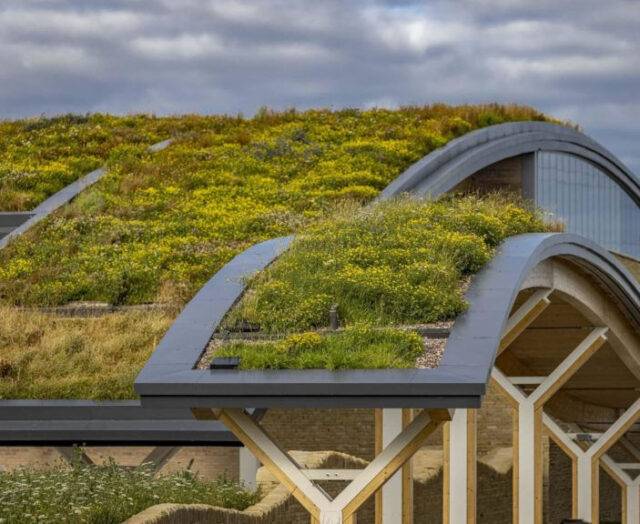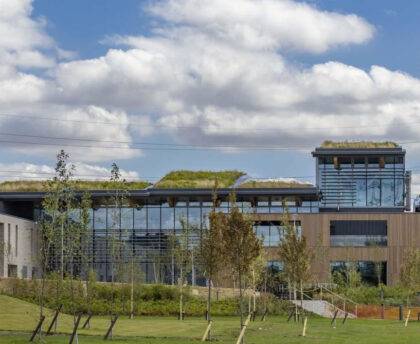
Designed by Corstorphine Wright Architects, Skelton Lake Services are located adjacent to Skelton Lake, a substantial area of ecologically diverse country park, 2 miles southeast of Leeds city centre.
The development focuses on providing a wide choice of food outlets and business, leisure and community facilities within attractive and relaxing natural surroundings.
To minimise the visual impact of the development on the natural landscape, the main 5,277m2 amenity building features a substantial green (‘living’) roof. The roof is split into separate sections and forms a unique ribbon pattern. The green roof and its timber eaves blend in perfectly with the nearby woodland and lake.
The Project
 Access Irrigation were responsible for the design and supply of the complete irrigation system for watering the green roof. In addition, we were also responsible for the installation of the pump & tank units.
Access Irrigation were responsible for the design and supply of the complete irrigation system for watering the green roof. In addition, we were also responsible for the installation of the pump & tank units.
As the roof involved a substantial number of 10 separate main ribbons, we split the roof into 3 sperate Areas – A, B and C. Each area was then divided into separate zones – to ensure that sufficient water flow was available for each zone.
Area A was split into 11 separate zones – using a Heron Mi-12 controller to automate the watering of each zone. A 2500-litre tank was used with a Espa Acuapres submersible pump incorporated into the tank, with the controller and pump & tank being located on the roof of the building.
Area B was split into 3 separate zones using a Heron Ma-6 controller. A 500-litre tank was used with an Espa Acuapres submersible pump incorporated into the tank, with the controller and pump & tank being located within the service yard, at ground level.
Area C formed a single zone using a Heron Ma-6 controller. A 91-litre tank was used with a 1.1kW Divertron submersible pump incorporated into the tank, with the controller and pump & tank being located on the roof of the building.
Solenoid valves (housed in valve boxes) were used to operate each zone – with each valve being opened and closed in sequence by the irrigation controller – with multi core signal cable running from the controller to the valve boxes. When the first valve opens, the pump will detect a drop in pressure and will begin to operate in order to boost the pressure back up again. This will therefore cause water to flow through the first (now open) solenoid valve to water the first zone. When the controller closes the first valve, the water flow will cease, and pressure will begin to build again. Once pressure has increased to its original level, the pump will stop operating. This process will repeat throughout the opening and closing of each valve in turn, until all zones have been watered. The valve boxes for Areas A and B being located at roof level and the valve box for Area C being located at the pump & tank unit itself.
MDPE supply pipe was used to run from the pump & tank to the solenoid valves, using compression fittings for connection. LDPE supply pipe was used to run from the solenoid valves to the dripline header pipe.
 Each ribbon was watered using Permadrip-Pro dripline (0.3m dripper spacing). Permadrip-Pro is a brown coloured dripline designed for landscape irrigation with a 16mm pipe diameter and a wall thickness of 1.2mm. The 1.6 L/h drip emitters are pressure compensating, ensuring uniform output over a wide pressure range and include a built-in anti-siphon mechanism, to prevent dirt being sucked into the drippers at the end of the irrigation cycle. These features make it ideal for sub-surface use and for use on sloping sites. The emitters also have a large inlet filter and unique, continually self-cleaning design, giving excellent resistance to blockages. All pipework connections were made using PoziLock fittings. Each run of dripline was laid on the roof surface at a distance of 1m apart to ensure even watering.
Each ribbon was watered using Permadrip-Pro dripline (0.3m dripper spacing). Permadrip-Pro is a brown coloured dripline designed for landscape irrigation with a 16mm pipe diameter and a wall thickness of 1.2mm. The 1.6 L/h drip emitters are pressure compensating, ensuring uniform output over a wide pressure range and include a built-in anti-siphon mechanism, to prevent dirt being sucked into the drippers at the end of the irrigation cycle. These features make it ideal for sub-surface use and for use on sloping sites. The emitters also have a large inlet filter and unique, continually self-cleaning design, giving excellent resistance to blockages. All pipework connections were made using PoziLock fittings. Each run of dripline was laid on the roof surface at a distance of 1m apart to ensure even watering.
The Result
Since the irrigation system has been installed the green roof has flourished and is now home to a mixture of over 30 different flower species, greatly adding to the biodiversity of the area. The green roof also helps filter dust and pollution from the air, thus reducing the amount of chemicals and pollutants that reach the surrounding river networks. We are delighted with the result and are proud to play our part in helping to create a greener planet.